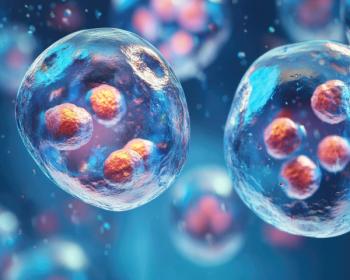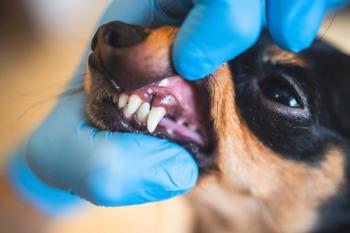
Managing challenging oral cases in dogs: part I (Proceedings)
Two basic techniques for the repair of palatal defects are most commonly utilized. The first technique involves removal of the epithelium from the edges of the defect and complete periosteal elevation of the palatine mucosa bilaterally on each side of the cleft.
The presentation will review the recognition and treatment of both congenital and acquired palatal defects as well as the management of mandibular fractures utilizing interdental splints.
Two basic techniques for the repair of palatal defects are most commonly utilized. The first technique involves removal of the epithelium from the edges of the defect and complete periosteal elevation of the palatine mucosa bilaterally on each side of the cleft. Bilateral releasing incisions are made along the upper dental arcade to permit apposition of the edges of the midline defect. The overlapping flap technique, the second basic technique, is preferred by most surgeons because there is less tension on the suture line, the suture line is not located directly over the defect, and the area of opposing connective tissue is larger which results in a stronger scar. The need for releasing incisions is also unnecessary in most cases with the overlapping flap technique.
The overlapping flap technique is performed by creating two mucoperiosteal flaps. One flap is hinged at the end of the palatal defect and is turned beneath the other flap. Vest-over-pants type sutures of synthetic absorbable suture material are utilized to maintain the connective tissue surfaces of both flaps in apposition. This technique provides a wide area of connective tissue contact without tension.
Cleft soft palatal defects are repaired using a double flap technique in which incisions are made along the medial margin of the palatal cleft on each side. A small scissors is utilized to divide the palatal tissue into a dorsal and ventral component. The two dorsal flaps are sutured together using absorbable suture material in a simple interrupted pattern with the knots located intranasally. The two ventral flaps are sutured using a similar material and pattern with the knots located intraorally. The edge of the repaired soft palate should reach the midpoint or caudal end of the tonsils and oppose the tip of the epiglottis when the tongue is in normal position.
Acquired palatal defects that have etiologies other than dental disease are usually located in the hard palate. These acquired palatal defects are caused by various types of trauma including dog bites, blunt head trauma, electrical shock, gunshot wounds, foreign body penetration and pressure necrosis. The acute inflammatory reaction and the overall clinical status of the patient with acute trauma should be managed prior to surgical correction of the palatal defect. Various surgical techniques can be utilized to repair acquired palatal defects including buccal flaps, rotation flaps, advancement flaps, tongue flaps, split palatal U-flaps and island flaps. The technique selected for repair of an acquired palatal defect depends on the location of the defect. In general the technique that will provide the largest flap with no tension is recommended.
Buccal flaps can be utilized to repair defects associated with oronasal fistulas secondary to periodontal disease. The edges of the defect are debrided to remove all of the epithelial margins of the palatal defect and divergent incisions are made mesial and distal to the defect through the gingiva, mucogingival line and alveolar mucosa. The periosteal layer of the flap is incised on the inner layer of the flap to release the tension on the flap prior to closure.
Rotation flaps are recommended for small circular defects especially defects located lateral to the midline. Large caudal defects that cross the midline can be repaired using an advancement flap. The defect is repaired by excising a thin section of mucosa from the perimeter of the defect and then creating a large mucoperiosteal flap caudal to the defect, incising the periosteal layer of the flap caudally, advancing the flap rostrally and suturing the flap over the defect with monofilament absorbable suture material in a simple interrupted pattern.
Tongue flaps may be used to repair large rostral palatal defects. The edges of the dorsal aspect of the tongue are excised and apposed to the debrided edges of the palatal defect. Approximately four weeks later the tongue is separated from the palate leaving enough tongue with the palate to close the defect without tension. Alternative techniques to tongue flaps are recommended whenever possible because of the high incidence of dehiscence associated with tongue flaps.
The split palatal U-flap can be used to repair acquired hard palatal defects located in the caudal hard palate. The edges of the palatal defect are debrided and a large U-shaped flap is created rostral to the defect. The major palatine arteries should be preserved during the creation of the U-flap. The U-flap is divided on the midline. One side of the U-flap is rotated 90 degrees into the defect and sutured in place. The second side of the U-flap is rotated 90 degrees and sutured to the previously rotated flap. The site from which the U-flap is harvested fills with granulation tissue and will be covered with epithelium in 4-8 weeks.
A variation of the split palatal U-flap, the island palatal flap has been used in the repair of a caudal palatal defect which occurred following an extensive caudal maxillectomy procedure. Caudal palatal defects in these types of cases are often located in areas that are deficient in local mucoperiosteal tissue with local perifistula tissues having tension at the time of initial repair, or subsequent to wound contraction. The island palatal flap in a previously reported case was harvested from the side of the palate that had remained intact following the previously performed caudal maxillectomy procedure. An island palatal flap is created by making a large, full-thickness, U-shaped flap positioned over the hemimaxilla with the base of the flap located caudal to the major palatine foramen. The mucoperiosteum is gently raised to avoid traumatizing the major palatine artery during its course along the hard palate and where it enters through the major palatine foramen approximately one centimeter palatal to the maxillary fourth premolar. The final caudal incision in made through the base of the flap at the level of the maxillary first molar to complete the harvesting of the island palatal mucoperiosteal flap. All flap incisions are full-thickness thereby isolating the attachments of the island palatal mucoperiosteal flap to the major palatine neurovascular pedicle. The margins of the fistula are debrided and the island palatal mucoperiosteal flap is rotated into the defect and sutured in place with monofilament absorbable suture material in a simple interrupted pattern. The portion of the rotated palatal flap bordering the denuded anteriorally located donor site is not sutured and the donor site is left to heal with granulation tissue and reepithelialization. The island palatal mucoperiosteal flap can be utilized in the repair of defects in the caudal oral cavity within a 180 degree rotation arc of the ipsilateral major palatine foramen.
Large single or bilateral buccal flaps can be utilized to repair large palatal defects that are more centrally located in the palate. In cases in which teeth are present in the region in which the buccal flaps are to be harvested, a staged procedure is required. The teeth in the region of the proposed buccal flaps are surgically extracted and the alveolar bone can be recontoured to reduce alveolar bone height as needed. Approximately eight weeks later the definitive surgical repair of the large palatal defect can be performed by created the buccal flaps as previously described, bilaterally if needed and advancing the flap(s) over the defect. Any palatal mucosa that will be located beneath the flap must be debrided of all epithelium to permit proper healing. In cases in which a bilateral buccal flap is utilized to cover large mid-palatal defect, overlapping the buccal flaps may provide additional strength for the repair by providing a double-layer closure over the defect. In these cases it is important to remove the epithelial layer in the region of the 1st buccal flap which will be covered by the second overlapping buccal flap.
Management of jaw fractures in dogs can be subdivided into three major categories including preoperative evaluation of patients, selection and utilization of appropriate techniques, and management of postoperative complications.
Prior to correction of jaw fractures the patient must be thoroughly evaluated for other traumatic injuries. Following stabilization of life-threatening injuries jaw fractures can be evaluated under sedation or general anesthesia. The mandible, maxillofacial bones, and temporomandibular joints are palpated both extra- and intraorally for fractures. Radiographs are taken to localize the fracture sites. It is important to assess the full extent of all injuries keeping in mind that multiple fractures may be present.
The teeth need to be evaluated for periodontal and endodontic disease and their relationship to fracture lines must be determined. Pathologic fractures may occur in the mandible of dogs with severe periodontal disease through deep periodontal pockets. These pathologic fractures occur most frequently in the region of the mandibular first molars and canine teeth. Periodontally diseased teeth in a fracture line need to be extracted or hemisected to remove the periodontally affected tooth or root that predisposed the dog to the pathologic fracture. Retention of a periodontally diseased tooth or root in a fracture site inhibits fracture healing. If hemisection is chosen as the method of treatment, the retained root must be treated endodontically. In addition teeth that are fractured with pulpal exposure require endodontic therapy.
Teeth that are not diseased but are located in the fracture site can generally be retained. Prognostic factors of teeth in the fracture site have previously been reported with fractures extending along the periodontal ligament to the apex having the poorest prognosis. In general, it is probably best to retain teeth that significantly contribute to fracture stability as long as severe periodontal disease is not present and the fracture is acute.
Intraoral acrylic splints are an easy, noninvasive, versatile, and inexpensive technique for repairing jaw fractures. The splints are ideal for the repair of fractures rostral to the first molars. The use of Protemp Garant (Premier) is recommended for the fabrication of intraoral splints. Ultrasonic scaling of the teeth with pumicing the teeth of the teeth with fluoride free pumice followed by thorough rinsing is recommended. Acid etching of the teeth with 40% phosphoric acid gel and rinsing prior to splint application enhances retention of the splint to the teeth. In cases in which a diseased tooth root is located in the fracture site, a root amputation can be performed and a bone graft material can be placed in the alveolus prior to placement of the intraoral splint. Interdental wires can be preplaced to help hold the fracture in reduction prior to preparation of the teeth. The splint is easily created directly on and around the teeth with the self-mixing Protemp Garant tip and a composite spatula. The fracture is held in reduction until the desired splint thickness is attained and the splint becomes hard.
Intercanine acrylic splinting between the mandibular and maxillary teeth can be utilized to stabilize caudal mandibular fractures and easily reduced but unstable temporomandibular luxations. Alternative techniques when possible are recommended because of the difficulty in managing patients with their mouth's partially opened for a 4 week period. If other treatment modalities are likely to be unsuccessful in achieving stabilization then intercanine acrylic splinting between the mandibular and maxillary canine teeth will usually provide a successful result. Placement of an esophagostomy feeding in these patients is often beneficial in maintaining proper nutritional intake.
The following steps are utilized in the placement of intercanine mandibular/maxillary acrylic splinting. The patient is anesthetized and routinely intubated with an endotracheal tube. The canine teeth are scaled and polished with pumice. The teeth are rinsed and dried well. The teeth are acid etched for 60 seconds with 40% phosphoric acid gel and the teeth are rinsed and dried well. An assistant holds the teeth in proper alignment with the incisors separated enough so that the tongue can be extended for eating if an esophagostomy tube is not placed usually 8-10mm from incisor tip to incisor tip. With the teeth held in proper alignment the operator applies a self curing acrylic material to fabricate a bridge between the upper and lower canine teeth forming two vertical pillars of acrylic material between the canine teeth. The acrylic material is gently molded with a plastic instrument and allowed to harden. When the acrylic is cured based on manufacturer's recommended setting time, the rough and irregular surfaces of the acrylic splints are eliminated with a diamond bur and sanding discs. Moistened gauze sponges can be placed in the mouth prior to burring and sanding to prevent accumulation of small particles of acrylic from accumulating in the oral cavity which may be difficult to remove. Once the splints are smooth, the gauze sponges are removed and residual acrylic particles may be rinsed from the mouth with an air/water syringe and cotton tipped swabs.
Interdental acrylic splints are removed following radiographic confirmation of fracture healing. The splint is removed by sectioning the splint interdentally with a bur and removing the splint in segments using an extraction forceps in a gentle shearing motion or small feline periosteal elevator with a shearing motion at the base of the crown. Following removal of the acrylic splint the teeth are polished.
References:
Manfra Marretta S. Maxillofacial surgery. Vet Clin North Amer (Small Anim Pract) 28(5):1285-1296, 1998.
Hedlund CS. Surgery of the oral cavity and oropharynx. In: Fossum TW, ed. Small Animal Surgery; 2nd ed, St. Louis: Mosby; 274-306, 2002.
Harvey CE, Emily PP. Oral surgery. In: Harvey CE, Emily PP, eds. Small Animal Dentistry. St. Louis, Mosby; 312-377,1993.
Manfra Marretta S. Palatal defects. In: Harari J, ed. Small Animal Surgery Secrets, Philadelphia: Hanley & Belfus, Inc; 347-350, 2000.
Manfra Marretta S. Dentistry and diseases of the oropharynx. In: Birchard SJ, Sherding RG, eds. Saunders Manual of Small Animal Practice, 2nd ed, Philadelphia: WB Saunders; 702-725, 2000.
Dvorak LD, Beaver DP, Ellison GW, Bellah JR, Mann FA, Henry CJ. Major glossectomy in dogs: A case series and proposed classification system. Jour Amer Anim Hosp Assoc 40:331-337, 2004.
Schloss AJ, Manfra Marretta S: Prognostic factors affecting teeth in the line of mandibular fractures. J Vet Dent 7(4):7, 1990.
Wallace J, Kapatkin A, Manfra Marretta S. Dental composite for the fixation of mandibular fractures and luxations in 11 cats and 6 dogs. Vet Surg 1994;23:190-194.
Manfra Marretta S, Grove TK, Grillo JF. Split palatal U-flap: A new technique for repair of caudal hard palate defects J Vet Dent 8(1):5-8, 1991.
Robertson JJ, Dean PW. Repair of a traumatically induced oronasal fistula in a cat with a rostral tongue flap. Vet Surg 16(2):164-166, 1987.
Smith MM. Island palatal mucoperiosteal flap for repair of oronasal fistula in a dog. J Vet Dent 18(3):127-129, 2001.
Newsletter
From exam room tips to practice management insights, get trusted veterinary news delivered straight to your inbox—subscribe to dvm360.






